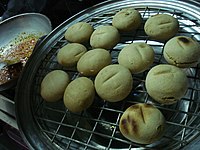Sattu
Sattu (Hindi: सत्तू) is a type of flour, mainly used in India, Nepal, Tibet and Pakistan. Sattu is a type of flour made up of dry roasted and ground
In Bihar, Sattu is usually made from dry roasted
Etymology
The
History
The origin of Sattu is the
Uses

Sattu is used in regional cuisines in varying degrees. In
Sattu mixed with a little mustard oil and some spices is used as a stuffing in the traditional Bihari food
In Punjab, it is used as a cold drink to mitigate heat and dehydration effects. It is a popular traditional summer drink in Pakistan’s Punjab region as well. The traditional way is to mix it with water and shakker (Punjabi) (Urdu) (Hindi) (jaggery). It is usually served cold. In Punjab, sattu is often a mix of toasted, ground barley.
In Odisha, it is a popular breakfast and is also called chhatua. Though there are many different ways to prepare chhatua, it is generally mixed with ripe bananas, cottage cheese (chenna), yogurt or milk.
Sattu made from ground barley can also be mixed with salt and
Ingredients
Sattu is prepared by dry-roasting grains or grams, most often barley or Bengal gram. In Odisha, Sattu or Chatua is made by dry-roasting cashew, almond, millet, barley and chickpea and grinding to a fine flour. The traditional way of preparing sattu involves the use of an iron vessel in which the grains or grams are roasted in sand. Afterwards, they are sieved and then ground into a fine flour.
Geography
In
References
- ^ Dasa, Syamasundara (1965–1975). "Hindi sabdasagara". dsal.uchicago.edu. Retrieved 2022-12-29.
- ^ Turner, R. L. (Ralph Lilley) (1962–1966). "A Comparative Dictionary of Indo-Aryan Languages". dsal.uchicago.edu. Retrieved 2022-12-29.
- ^ "Monier-Williams Sanskrit-English Dictionary --स". sanskrit.inria.fr. Retrieved 2022-12-29.
- ^ www.wisdomlib.org (2016-03-18). "Saktu, Shaktu, Śaktu: 21 definitions". www.wisdomlib.org. Retrieved 2022-12-29.
- ^ ISBN 81-7142-869-X.
- ^ Kumar Suresh Singh, Anthropological Survey of India (2008). People of India, Volume 16, Part 1. p. xxix. "However this term of opprobrium ignores the fact that the sattu is nutritious and has sustained the Bihari..."
